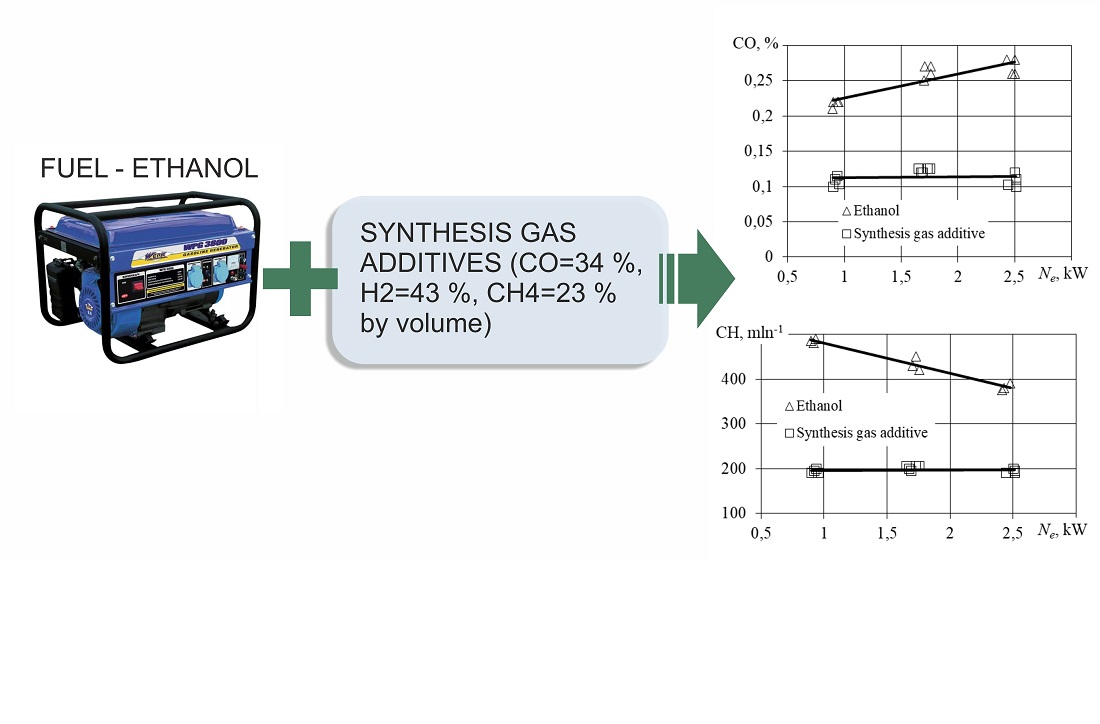Determining the influence of synthesis gas additives on the environmental performance of internal combustion engine
DOI:
https://doi.org/10.15587/1729-4061.2024.302150Keywords:
synthesis gas, fuel ethanol, thermochemical utilization, exhaust gases, air ratioAbstract
The object of research is the environmental parameters of a reciprocating engine when using a synthesis gas additive to the main fuel. The research is aimed at solving the problem of reducing the concentration of harmful components in the exhaust gases of an internal combustion engine by adding synthesis gas to the main fuel.
Experimentally, the dependences of the effect of the addition of synthesis gas to ethanol on the change in the environmental performance of a piston engine with spark ignition were obtained.
The positive effect of the addition of synthesis gas obtained by thermochemical conversion to ethanol in an amount of up to 5 % by weight on the environmental performance of a spark-ignition piston engine was established. Provided that the engine achieves the same effective power, the use of a synthesis gas additive to the main fuel made it possible to reduce the concentration of CO by 61.5 % and CH by 51.3 % in the exhaust gases. no more than 25–30 words
The addition of synthesis gas contributed to the formation of radicals that activate oxidation chain reactions, and also made it possible to increase the normal combustion rate of the fuel-air mixture by 6.25 %. This ensures normal engine operation on a leaner fuel-air mixture (α=1.21) without deterioration of environmental, energy and economic performance. no more than 25-30 words
The simultaneous reduction of the concentration of harmful components in the exhaust gases and engine efficiency can be achieved by using fuels with a wide concentration limit of ignition and high combustion rate in a lean mixture.
The experimental data obtained can be used in the design or modernization of transport and stationary power plants with internal combustion engines as an approach to meet ever-increasing environmental standards
References
- Paykani, A., Chehrmonavari, H., Tsolakis, A., Alger, T., Northrop, W. F., Reitz, R. D. (2022). Synthesis gas as a fuel for internal combustion engines in transportation. Progress in Energy and Combustion Science, 90, 100995. https://doi.org/10.1016/j.pecs.2022.100995
- Hagos, F. Y., Aziz, A. R. A., Sulaiman, S. A. (2014). Trends of Syngas as a Fuel in Internal Combustion Engines. Advances in Mechanical Engineering, 6, 401587. https://doi.org/10.1155/2014/401587
- Pradhan, A., Baredar, P., Kumar, A. (2015). Syngas as An Alternative Fuel Used in Internal Combustion Engines: A Review. Journal of Pure and Applied Science & Technology, 5 (2), 51–66. Available at: https://www.researchgate.net/publication/280008135_Syngas_as_An_Alternative_Fuel_Used_in_Internal_Combustion_Engines_A_Review
- Sookramoon, K. (2018). Syngas from Updraft Gasifier Incineration for Internal Combustion Engine Power Generation in Klongluang PathumThani Thailand. MATEC Web of Conferences, 187, 03002. https://doi.org/10.1051/matecconf/201818703002
- Sahoo, B. B., Saha, U. K., Sahoo, N. (2011). Effect of Load Level on the Performance of a Dual Fuel Compression Ignition Engine Operating on Syngas Fuels With Varying H2/CO Content. Journal of Engineering for Gas Turbines and Power, 133 (12). https://doi.org/10.1115/1.4003956
- Rabello de Castro, R., Brequigny, P., Mounaïm-Rousselle, C. (2022). A multiparameter investigation of syngas/diesel dual-fuel engine performance and emissions with various syngas compositions. Fuel, 318, 123736. https://doi.org/10.1016/j.fuel.2022.123736
- Mahgoub, B. K. M., Hassan, S., Sulaiman, S. A., Mamat, R., Abdullah, A. A., Hagos, F. Y. (2017). Combustion and Performance of Syngas Dual Fueling in a CI Engine with Blended Biodiesel as Pilot Fuel. BioResources, 12 (3). https://doi.org/10.15376/biores.12.3.5617-5631
- Azimov, U., Tomita, E., Kawahar, N. (2013). Combustion and Exhaust Emission Characteristics of Diesel Micro-Pilot Ignited Dual-Fuel Engine. Diesel Engine - Combustion, Emissions and Condition Monitoring. https://doi.org/10.5772/54613
- Shudo, T. (2008). Influence of gas composition on the combustion and efficiency of a homogeneous charge compression ignition engine system fuelled with methanol reformed gases. International Journal of Engine Research, 9 (5), 399–408. https://doi.org/10.1243/14680874jer01208
- Mytrofanov, O., Proskurin, A., Poznanskyi, A. (2018). Analysis of the piston engine operation on ethanol with the synthesis-gas additives. Eastern-European Journal of Enterprise Technologies, 4 (1 (94)), 14–19. https://doi.org/10.15587/1729-4061.2018.136380
- Mytrofanov, O., Poznanskyi, A., Proskurin, A., Shabalin, Y. (2019). Research into the recovery of exhaust gases from ice using an expansion machine and fuel conversion. Eastern-European Journal of Enterprise Technologies, 4 (5 (100)), 32–38. https://doi.org/10.15587/1729-4061.2019.174061

Downloads
Published
How to Cite
Issue
Section
License
Copyright (c) 2024 Oleksandr Mytrofanov, Arkadii Proskurin

This work is licensed under a Creative Commons Attribution 4.0 International License.
The consolidation and conditions for the transfer of copyright (identification of authorship) is carried out in the License Agreement. In particular, the authors reserve the right to the authorship of their manuscript and transfer the first publication of this work to the journal under the terms of the Creative Commons CC BY license. At the same time, they have the right to conclude on their own additional agreements concerning the non-exclusive distribution of the work in the form in which it was published by this journal, but provided that the link to the first publication of the article in this journal is preserved.
A license agreement is a document in which the author warrants that he/she owns all copyright for the work (manuscript, article, etc.).
The authors, signing the License Agreement with TECHNOLOGY CENTER PC, have all rights to the further use of their work, provided that they link to our edition in which the work was published.
According to the terms of the License Agreement, the Publisher TECHNOLOGY CENTER PC does not take away your copyrights and receives permission from the authors to use and dissemination of the publication through the world's scientific resources (own electronic resources, scientometric databases, repositories, libraries, etc.).
In the absence of a signed License Agreement or in the absence of this agreement of identifiers allowing to identify the identity of the author, the editors have no right to work with the manuscript.
It is important to remember that there is another type of agreement between authors and publishers – when copyright is transferred from the authors to the publisher. In this case, the authors lose ownership of their work and may not use it in any way.









